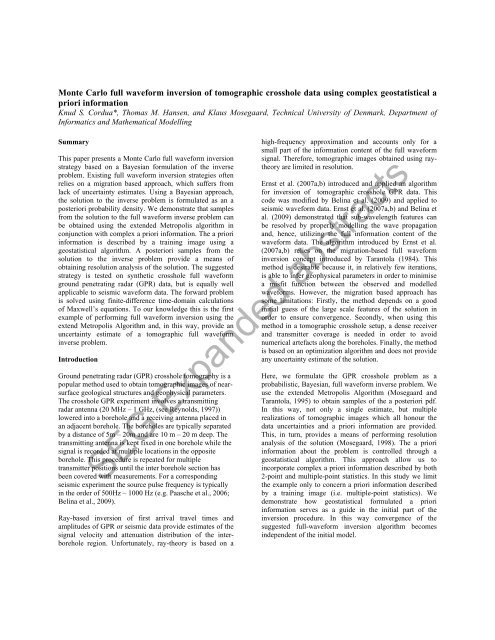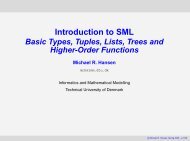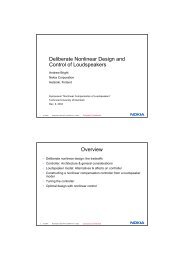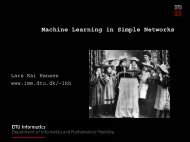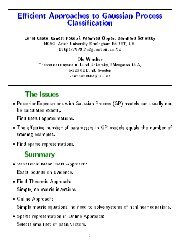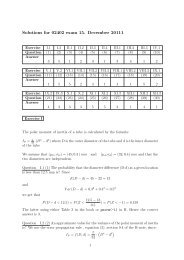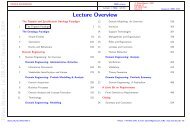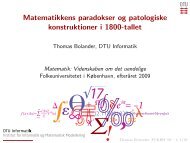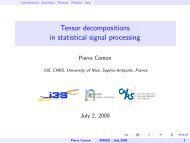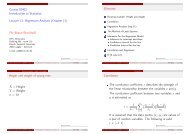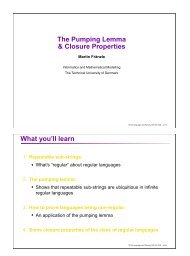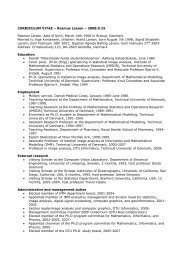Monte Carlo full waveform inversion of tomographic crosshole
Monte Carlo full waveform inversion of tomographic crosshole
Monte Carlo full waveform inversion of tomographic crosshole
You also want an ePaper? Increase the reach of your titles
YUMPU automatically turns print PDFs into web optimized ePapers that Google loves.
<strong>Monte</strong> <strong>Carlo</strong> <strong>full</strong> <strong>waveform</strong> <strong>inversion</strong> <strong>of</strong> <strong>tomographic</strong> <strong>crosshole</strong> data using complex geostatistical apriori informationKnud S. Cordua*, Thomas M. Hansen, and Klaus Mosegaard, Technical University <strong>of</strong> Denmark, Department <strong>of</strong>Informatics and Mathematical ModellingSummaryThis paper presents a <strong>Monte</strong> <strong>Carlo</strong> <strong>full</strong> <strong>waveform</strong> <strong>inversion</strong>strategy based on a Bayesian formulation <strong>of</strong> the inverseproblem. Existing <strong>full</strong> <strong>waveform</strong> <strong>inversion</strong> strategies <strong>of</strong>tenrelies on a migration based approach, which suffers fromlack <strong>of</strong> uncertainty estimates. Using a Bayesian approach,the solution to the inverse problem is formulated as an aposteriori probability density. We demonstrate that samplesfrom the solution to the <strong>full</strong> <strong>waveform</strong> inverse problem canbe obtained using the extended Metropolis algorithm inconjunction with complex a priori information. The a prioriinformation is described by a training image using ageostatistical algorithm. A posteriori samples from thesolution to the inverse problem provide a means <strong>of</strong>obtaining resolution analysis <strong>of</strong> the solution. The suggestedstrategy is tested on synthetic <strong>crosshole</strong> <strong>full</strong> <strong>waveform</strong>ground penetrating radar (GPR) data, but is equally wellapplicable to seismic <strong>waveform</strong> data. The forward problemis solved using finite-difference time-domain calculations<strong>of</strong> Maxwell’s equations. To our knowledge this is the firstexample <strong>of</strong> performing <strong>full</strong> <strong>waveform</strong> <strong>inversion</strong> using theextend Metropolis Algorithm and, in this way, provide anuncertainty estimate <strong>of</strong> a <strong>tomographic</strong> <strong>full</strong> <strong>waveform</strong>inverse problem.IntroductionGround penetrating radar (GPR) <strong>crosshole</strong> tomography is apopular method used to obtain <strong>tomographic</strong> images <strong>of</strong> nearsurfacegeological structures and geophysical parameters.The <strong>crosshole</strong> GPR experiment involves a transmittingradar antenna (20 MHz – 1 GHz, (see Reynolds, 1997))lowered into a borehole and a receiving antenna placed inan adjacent borehole. The boreholes are typically separatedby a distance <strong>of</strong> 5m – 20m and are 10 m – 20 m deep. Thetransmitting antenna is kept fixed in one borehole while thesignal is recorded at multiple locations in the oppositeborehole. This procedure is repeated for multipletransmitter positions until the inter borehole section hasbeen covered with measurements. For a correspondingseismic experiment the source pulse frequency is typicallyin the order <strong>of</strong> 500Hz – 1000 Hz (e.g. Paasche et al., 2006;Belina et al., 2009).Ray-based <strong>inversion</strong> <strong>of</strong> first arrival travel times andamplitudes <strong>of</strong> GPR or seismic data provide estimates <strong>of</strong> thesignal velocity and attenuation distribution <strong>of</strong> the interboreholeregion. Unfortunately, ray-theory is based on ahigh-frequency approximation and accounts only for asmall part <strong>of</strong> the information content <strong>of</strong> the <strong>full</strong> <strong>waveform</strong>signal. Therefore, <strong>tomographic</strong> images obtained using raytheoryare limited in resolution.Ernst et al. (2007a,b) introduced and applied an algorithmfor <strong>inversion</strong> <strong>of</strong> <strong>tomographic</strong> <strong>crosshole</strong> GPR data. Thiscode was modified by Belina et al. (2009) and applied toseismic <strong>waveform</strong> data. Ernst et al. (2007a,b) and Belina etal. (2009) demonstrated that sub-wavelength features canbe resolved by properly modelling the wave propagationand, hence, utilizing the <strong>full</strong> information content <strong>of</strong> the<strong>waveform</strong> data. The algorithm introduced by Ernst et al.(2007a,b) relies on the migration-based <strong>full</strong> <strong>waveform</strong><strong>inversion</strong> concept introduced by Tarantola (1984). Thismethod is desirable because it, in relatively few iterations,is able to infer geophysical parameters in order to minimisea misfit function between the observed and modelled<strong>waveform</strong>s. However, the migration based approach hassome limitations: Firstly, the method depends on a goodinitial guess <strong>of</strong> the large scale features <strong>of</strong> the solution inorder to ensure convergence. Secondly, when using thismethod in a <strong>tomographic</strong> <strong>crosshole</strong> setup, a dense receiverand transmitter coverage is needed in order to avoidnumerical artefacts along the boreholes. Finally, the methodis based on an optimization algorithm and does not provideany uncertainty estimate <strong>of</strong> the solution.Here, we formulate the GPR <strong>crosshole</strong> problem as aprobabilistic, Bayesian, <strong>full</strong> <strong>waveform</strong> inverse problem. Weuse the extended Metropolis Algorithm (Mosegaard andTarantola, 1995) to obtain samples <strong>of</strong> the a posteriori pdf.In this way, not only a single estimate, but multiplerealizations <strong>of</strong> <strong>tomographic</strong> images which all honour thedata uncertainties and a priori information are provided.This, in turn, provides a means <strong>of</strong> performing resolutionanalysis <strong>of</strong> the solution (Mosegaard, 1998). The a prioriinformation about the problem is controlled through ageostatistical algorithm. This approach allow us toincorporate complex a priori information described by both2-point and multiple-point statistics. In this study we limitthe example only to concern a priori information describedby a training image (i.e. multiple-point statistics). Wedemonstrate how geostatistical formulated a prioriinformation serves as a guide in the initial part <strong>of</strong> the<strong>inversion</strong> procedure. In this way convergence <strong>of</strong> thesuggested <strong>full</strong>-<strong>waveform</strong> <strong>inversion</strong> algorithm becomesindependent <strong>of</strong> the initial model.SEG Expanded abstracts
<strong>Monte</strong> <strong>Carlo</strong> <strong>full</strong> <strong>waveform</strong> <strong>inversion</strong>MethodologyConsider that the subsurface can be represented by adiscrete set <strong>of</strong> model parameters, m , and that a data set,d , <strong>of</strong> indirect observations <strong>of</strong> the model parameters isprovided. The model parameters describe some physicalproperties <strong>of</strong> the subsurface that influences the dataobservations. Hence, the forward relation between themodel parameters (i.e. the model) and the data observationscan be expressed as (e.g. Tarantola, 2005):d = g( m ), (1)where g is a linear or non-linear mapping operator which<strong>of</strong>ten relies on a physical law. Here, the forward relation inequation (1) is given as a finite-difference time-domainsolution <strong>of</strong> Maxwell’s equations. However, any numericalwave propagation modelling strategy for GPR or seismicsignals can be applied. The inverse problem is to inferinformation about the model parameters based on a set <strong>of</strong>observations, a priori information about the model, and theforward relation between the model and the dataobservations.In a Bayesian formulation the solution to the inverseproblem is given as an a posteriori probability density,which can be formulated as (e.g. Tarantola, 2005):σ ( m) = kρ( m) L( m ), (2)MMwhere k is a normalization constant, ρM( m)is the a prioriprobability density, and L( m)is the likelihood function.ρ ( ) Mm describes the probability that the model satisfiesthe a priori information. L( m)describes how well themodelled data explains the observed data given a datauncertainty. Hence, the a posteriori probability densitydescribes the probability that a certain model is a solutionto the inverse problem.A highly nonlinear inverse problem refers to the case wherethe a priori probability density is far from being Gaussianor the forward relation between the model and data are farfrom being linear. In the case <strong>of</strong> <strong>full</strong> <strong>waveform</strong> <strong>inversion</strong>the forward relation is expected to be highly nonlinear.Moreover, the a priori information described by a trainingimage is highly non-Gaussian.The extended Metropolis algorithm is a versatile toolwhich, in particular, is useful to obtain samples fromsolutions to non-linear inverse problems using arbitrarilycomplex a priori information. The minimum requirement <strong>of</strong>the algorithm is; 1) a “black box” algorithm that is able tosample the a priori probability density and, 2) a “black box”algorithm that is able to compute the likelihood for a givenset <strong>of</strong> model parameters. The flowchart <strong>of</strong> the extendedMetropolis algorithm is as follows: 1) The a priori samplerproposes a sample, mpropose, from the a priori probabilitydensity, which is a perturbation <strong>of</strong> a previous acceptedmodel, m accept. 2) The proposed sample is accepted with theprobability (known as the Metropolis rule):Paccept⎛ L( m ) ⎞propose= min 1,⎜L( accept) ⎟⎝ m ⎠3) If the proposed model is accepted, mproposethe a posteriori probability andOtherwisempropose(3)is a sample <strong>of</strong>mproposebecomes maccept.is rejected. 4) The procedure iscontinued until a desirable number <strong>of</strong> models have beenaccepted.In this study the algorithm that provides the a prioriinformation is the Single Normal Equation SIMulation(snesim) algorithm, which is a fast geostatistical algorithmthat produces samples (conditional or unconditional) froman a priori probability density defined by a training imagefor a relatively low number <strong>of</strong> categorical values (Strebelle,2002). Hansen et al. (2008) suggest a strategy termedperturbed simulation, which is capable <strong>of</strong> producingperturbations <strong>of</strong> spatial distributions using geostatisticalalgorithms. Thus, perturbed simulation serves as a “blackbox” that produces samples <strong>of</strong> a priori probability densitiesdescribed by both two-point and multiple-point statistics.The flow <strong>of</strong> this algorithm is as follows: 1) An initialunconditional sample <strong>of</strong> the a priori probability density(here defined by a training image) is provided. 2) A subarea<strong>of</strong> the sample is randomly chosen. 3) The model parameterswithin this area are set to unknown. 4) The unknown modelparameters are resimulated conditional to the rest <strong>of</strong> themodel parameters using a geostatistical algorithm (heresnesim) and a perturbation is obtained. 5) This procedure isrepeated in order to obtain multiple samples <strong>of</strong> the a prioriprobability density.The size <strong>of</strong> the perturbation area governs the exploratorynature <strong>of</strong> the Metropolis algorithm. The size <strong>of</strong> theperturbation area is chosen subjectively. In the extreme casewhere the area covers the entire model the outcome <strong>of</strong> theperturbed simulation algorithm is uncorrelated to theprevious model. Contrary, if the area only constitutes asingle model parameter, the perturbed model is highlycorrelated with the initial model. According to themetropolis rule a small perturbation area results in aproposed model that is more probable <strong>of</strong> being accepted ascompared to a proposed model obtained using a largerperturbation area. Therefore, the perturbation area shouldSEG Expanded abstracts
<strong>Monte</strong> <strong>Carlo</strong> <strong>full</strong> <strong>waveform</strong> <strong>inversion</strong>be chosen care<strong>full</strong>y in order to ensure an efficientalgorithm. Gelman et al. (1996) found that the acceptancerate should be around 23% for high-dimensionaldistributions. For large acceptance rates the algorithm isexploring the a posteriori probability density too slowly. Onthe other hand, for smaller acceptance rates too manycomputationally expensive trials are performed. Therefore,we suggest to automatically change the size <strong>of</strong> theperturbation area while running the algorithm such that acertain acceptance rate is maintained. A constantacceptance rate results in a larger perturbation area in theburn-in period than in the subsequent sampling period.This effect is beneficial because the algorithm needs toperform large perturbations in the initial part in order t<strong>of</strong>ind models <strong>of</strong> large probability and, hence, producerepresentative samples <strong>of</strong> the a posteriori probabilitydensity.Finally, the likelihood function is defined as a Gaussiandistribution:⎛ 1⎞L( ) kexp ( g( ) d )/ σ⎝⎠Ni i 2m = ⎜− ∑ m −obs ⎟, (4)2 i = 1where g( m) i represents the amplitude <strong>of</strong> the individualsample points <strong>of</strong> all the simulated <strong>waveform</strong>s obtainedithrough equation (1) (i.e. the FDTD algorithm) and ared obsthe sample points <strong>of</strong> the observed <strong>waveform</strong> data. σ is thestandard deviation <strong>of</strong> the expected amplitude uncertainty <strong>of</strong>the <strong>waveform</strong> data.Results and discussionFigure 1 shows a training image that mimic a matrix <strong>of</strong> claywith embedded channels <strong>of</strong> unconsolidated sand.Electromagnetic signals in near surface sediments aresensitive to the dielectric permittivity and the electricalconductivity <strong>of</strong> the materials. In this study we limitourselves only to consider the influence <strong>of</strong> the dielectricpermittivity, which is primarily governing the phasevelocity <strong>of</strong> the signal. Water saturation <strong>of</strong> clay is <strong>of</strong>ten highcompared to sandy deposits. Therefore, the dielectricpermittivity <strong>of</strong> the clay is set to a relative dielectricpermittivity <strong>of</strong> εr≈ 4,57 (0,14m/ns) and the permittivity <strong>of</strong>the sand channels is set to εr≈ 2,75 (0,18m/ns) (e.g. Toppet al., 1980). Figure 2 (left) is the synthetic reference to beconsidered and is, at the same time, an unconditionalsample <strong>of</strong> the training image obtained using snesim. Theelectrical conductivity is set to a constant value <strong>of</strong> 3 mS/mand is, in the following, assumed known.A <strong>full</strong> <strong>waveform</strong> synthetic data set is calculated using theFDTD algorithm. A Ricker wavelet with a centralfrequency <strong>of</strong> 100 MHz is used as source pulse. The sourcepulse is assumed known during the <strong>inversion</strong>. Thetransmitter and receiver positions are separated by 2 m and0.25 m, respectively (see figure 2 left). Data acquired with atransmitter-receiver angle larger than 45 degrees fromhorizontal are omitted since, in practice, these data areviolated by effects <strong>of</strong> wave guiding in the boreholes (cf.Peterson, 2001). This leads to a total <strong>of</strong> 248 dataobservations (i.e. recorded <strong>waveform</strong>s).Depth [m]05101520250 5 10 15 20 25Distance [m]Figure 1. Training image which mimic sandy channelstructures embedded in a matrix <strong>of</strong> clay deposits.Depth [m]0246810Reference model120 2 4Distance [m]Distance [m]Figure 2. Left) Synthetic reference model. Black asterisksshow transmitter positions and the yellow dots showreceiver positions. Right) The initial model used as inputfor the <strong>inversion</strong>.0Initial guess120 2 4SEG Expanded abstractsNoise is subsequently added to the data by performing arandom phase shifting <strong>of</strong> the synthetic <strong>waveform</strong>s. Thephase shift is normal distributed with zero mean and astandard deviation <strong>of</strong> 0.4 ns since this is a typicalmagnitude found in GPR travel time data (e.g. Looms et al,in press). The phase shift results in an amplitude2468104.64.44.243.83.63.43.232.82.6Relative dielectric permittivity ( ε/ε 0)4.64.44.243.83.63.43.232.82.6Relative dielectric permittivity ( ε/ε 0)
<strong>Monte</strong> <strong>Carlo</strong> <strong>full</strong> <strong>waveform</strong> <strong>inversion</strong>3uncertainty with a standard deviation <strong>of</strong> 10 − . Accordingly,the standard deviation <strong>of</strong> the data uncertainties, σ , is set to3. The standard deviation <strong>of</strong> the amplitude noise isindicated by the red error bar in figure 3 and compared withtwo <strong>waveform</strong>s recorded at 0 degrees (short <strong>of</strong>fset / highamplitude) and 45 degrees transmitter-receiver angles (long<strong>of</strong>fset / low amplitude), respectively.1Recorded at short <strong>of</strong>fset0.5Recorded at long <strong>of</strong>fset0-0.5-110 − 100 150 200 250 300 350 400Normalized amplitudeSample no.Figure 3. Dashed line is a <strong>waveform</strong> recorded at shorttransmitter-receiver <strong>of</strong>fset (0 degrees). Solid line is a<strong>waveform</strong> recorded at long <strong>of</strong>fset (45 degrees). The height<strong>of</strong> the red errorbar indicates 2 times the standard deviation<strong>of</strong> the noise added to the data.Depth [m]05100 2 405100 2 405100 2 4Distance [m]05100 2 405100 2 4Figure 4. Five statistically independent samples from the aposteriori probability density <strong>of</strong> the <strong>full</strong> <strong>waveform</strong> inverseproblem.The initial model used for the Metropolis algorithm ischosen as an unconditional sample <strong>of</strong> the training imageusing a different random seed than for the reference model(see figure 2 right). Burn-in was reached after 2000accepted models. Hereafter samples accepted by theMetropolis rule are representative samples <strong>of</strong> the aposteriori probability density. Figure 4 shows the 2000 th ,6000 th , 1000 th , 14000 th , and 18000 th accepted sample usinga priori information defined by the training image (figure 1)and Gaussian data uncertainty (equation 4). Only a slightdeviation between the individual samples is seen, whichindicates little a posteriori model uncertainty. Figure 5shows the a posteriori mean and variance based on 18000samples from the a posteriori probability density after theburn-in period. From the a posteriori variance it is seen thatthe overall structures <strong>of</strong> the model is recovered (varianceclose to or equal to zero) whereas the higher variancesalong the edges between the clay and sand deposits aresubjected to uncertainty. A comparison between thereference model (figure 2 left) and the mean <strong>of</strong> the samples(figure 4 right) confirms that the <strong>waveform</strong> <strong>inversion</strong> is ableto recover the sand structures very well. Moreover, itshould be noted that the algorithm is able to reach theseresults even though it is initiated in a model uncorrelatedwith the reference model (compare figure 2 right and left).Depth [m]0246810Mean120 2 4Distance [m]4.64.44.243.83.63.43.232.82.6( ε/ε 0)0246810Variance120 2 4Distance [m]Figure 5. Mean (left) and variance (right) <strong>of</strong> 18000 samplesdrawn from the a posteriori probability density <strong>of</strong> thesolution to the <strong>full</strong> <strong>waveform</strong> inverse problem.The suggested <strong>Monte</strong> <strong>Carlo</strong> <strong>inversion</strong> strategy is preferablein that it allows for arbitrary antennae geometry.Furthermore, complex a priori <strong>inversion</strong> can be includedusing the perturbed simulation algorithm. Finally, a <strong>full</strong>data covariance matrix can be included in order to accountfor correlated data errors, which are <strong>of</strong>ten present in<strong>tomographic</strong> inverse problems (e.g. Maurer and Musil,2004; Cordua et al., 2008, 2009). However, note that thisexhaustive sampling strategy needs substantially morecomputationally expensive forward calculations comparedto the traditional migration based approach.ConclusionsWe have demonstrated the potential <strong>of</strong> producing samples<strong>of</strong> the solution to a <strong>tomographic</strong> <strong>full</strong> <strong>waveform</strong> inverseproblem using the extended Metropolis algorithm withcomplex a priori information. The methodology provides ameans <strong>of</strong> evaluating the a posteriori uncertainty, which isnot provided using optimisation based strategies for <strong>full</strong><strong>waveform</strong> <strong>inversion</strong>. Moreover, the present approach isrobust with regard to the initial guess <strong>of</strong> the solution and thetransmitter-receiver density. Finally, the extendedMetropolis Algorithm is flexible regarding the choice <strong>of</strong> apriori information and specification <strong>of</strong> data uncertainties.SEG Expanded abstracts0.80.70.60.50.40.30.20.10( ε 2 /ε 02 )
<strong>Monte</strong> <strong>Carlo</strong> <strong>full</strong> <strong>waveform</strong> <strong>inversion</strong>ReferencesBelina, F. A., J. R. Ernst, and K. Holliger, 2009, Integration<strong>of</strong> diverse physical-property models: Subsurface zonationand petrophysical parameter estimation based on fuzzy c-means cluster analyses: Journal <strong>of</strong> Applied Geophysics, 68,85 – 94.Cordua, K. S., M.C. Looms, and L. Nielsen, 2008,Accounting for correlated data errors during <strong>inversion</strong> <strong>of</strong>cross-borehole ground penetrating radar data: Vadose ZoneJournal, 7, 263 – 271.Cordua, K.S., L. Nielsen, M. C. Looms, T. M. Hansen, andA. Binley, 2009, Quantifying the influence <strong>of</strong> static-likeerrors in least-squares-based <strong>inversion</strong> and sequentialsimulation <strong>of</strong> cross-borehole ground penetrating radar data:Journal <strong>of</strong> Applied Geophysics, 68, 71 – 84.Ernst, J. R., A. G. Green, H. Maurer, and K. Holliger,2007a, Application <strong>of</strong> a new 2D time-domain <strong>full</strong><strong>waveform</strong><strong>inversion</strong> scheme to <strong>crosshole</strong> radar data:Geophysics, 72, J53 – J64.Ernst, J.R., H. Maurer, A. G. Green, and K. Holliger,2007b, Full-<strong>waveform</strong> <strong>inversion</strong> <strong>of</strong> <strong>crosshole</strong> radar databased on 2- D finite-difference time-domain solutions <strong>of</strong>maxwell’s equations: IEEE Transactions on Geoscienceand Remote Sensing, 45, 2807 – 2828.Gelman, A., G. O. Roberts, and W. R. Gilks, 1996,Efficient Metropolis jumping rules: Bayesian statistics, 5,599 – 607.Hansen, T. M., K. Mosegaard, and K. S. Cordua, 2008,Using geostatistics to describe complex a priori informationfor inverse problems, in J. M. Ortiz and X. Emery, eds.,Geostatistics 2008 Chile, vol. 1.Maurer, H.R. and M. Musil, 2004, Effects and removal <strong>of</strong>systematic errors in <strong>crosshole</strong> georadar attenuationtomography: Journal <strong>of</strong> Applied Geophysics, 55, 261 -260.Mosegaard, K., 1998, Resolution analysis <strong>of</strong> generalinverse problems through inverse <strong>Monte</strong> <strong>Carlo</strong> sampling:Inverse Problems, 14, 405 – 426.Mosegaard, K., and A. Tarantola, 1995, <strong>Monte</strong> <strong>Carlo</strong>sampling <strong>of</strong> solutions to inverse problems: Journal <strong>of</strong>geophysical research, 100, 431 – 447.Paasche, H., J. Tronicke, K. Holliger, A. G. Green, and H.Maurer, 2006, Integration <strong>of</strong> diverse physical-propertymodels: subsurface zonation and petrophysical parameterestimation based on fuzzy c-means cluster analyses:Geophysics, 71, H33–H44.Peterson, J.E., 2001, Pre-<strong>inversion</strong> correction and analysis<strong>of</strong> radar <strong>tomographic</strong> data: Journal <strong>of</strong> Environmental andEngineering Geophysics, 6, 1 – 18.Reynolds, J.M., 1997, An introduction to applied andenvironmental geophysics: John Wiley and Sons Ltd. Pp.Strebelle, S., 2002, Conditional simulation <strong>of</strong> somplexgeological structures using multiple-point statistics:Matehmatical geology, 34, 1 – 21.Tarantola, A., 2005, Inverse problem theory and methodsfor model parameter estimation: Society <strong>of</strong> Industrial andApplies Mathematics, Philadelphia, PA.Tarantola, A., 1984, Inversion <strong>of</strong> seismic reflection data inthe acoustic approximation: Geophysics, 49, 1259 – 1266.Topp, G.C., J. L. Davis, and A. P. Annan, 1980,Electromagnetic determination <strong>of</strong> soil water content:Measurements coaxial transmission lines: Water ResourcesResearch, 16, 574–582.SEG Expanded abstracts


